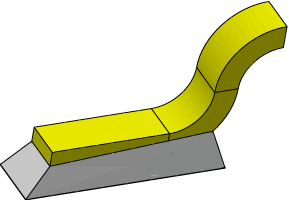Solder parameters:
We need to define the physical properties of the liquid solder, so we
put in some appropriate parameters:
parameter gamlv = 0.45 // Liquid-vapor surface energy of solder (Kg/s^2)
parameter den = 1.3e-10 // Density of solder (Kg/mil^3)
parameter mr_grav= 385000 // Acceleration of gravity (mil/s^2)
The internal gravitational constant is set to the proper value with
gravity_constant mr_grav
The values look a little strange because of the unusual mil-Kg-sec system
of units. Also we need to specify the contact angles:
//Contact angles on sides, foot, and bottom surfaces of lead, and pad
parameter theta_side = 20 // Contact angle on sides of the gull wing (degrees)
parameter theta_lower = 20 // Contact angle on the bottom surface of the gull wing (degrees)
parameter theta_toe = 20 // Contact angle on the toe of the gull wing (degrees)
parameter thetap = 20 // Wetting angle on the pad (degrees)
A contact angle is actually used to specify an equivalent contact surface
tension of the form -gamlv*cos(angle). In this datafile, this type of
tension will be applied to the contact facets; in gullwing-3.fe, it will
be incorporated into edge integrals.



